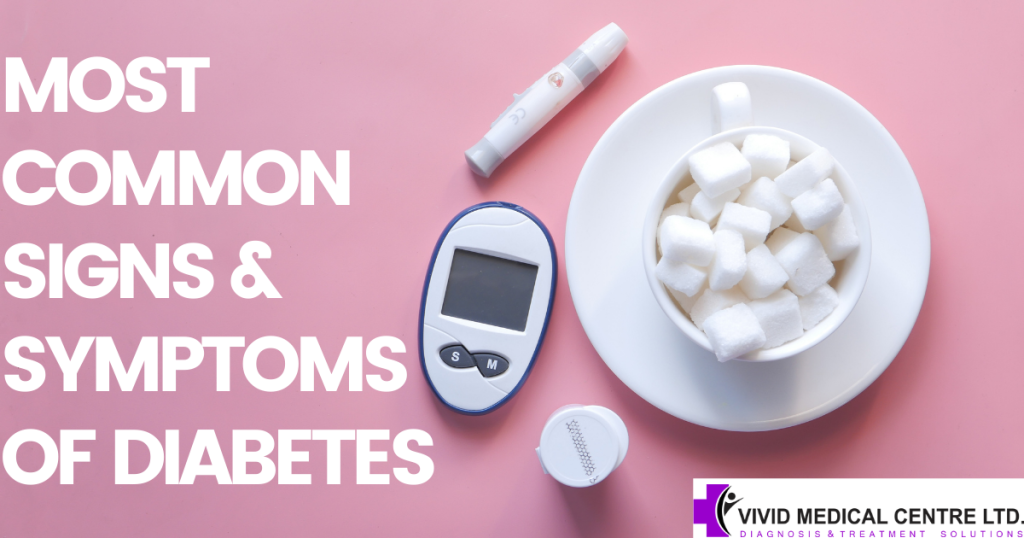Humans are enveloped by all kinds of deadly pathogens, organisms, and life forms that could easily lead us into morbid and even mortal health conditions, despite our well-built immune system. But some chronic conditions occur due to our negligence, and one such example is Diabetes. According to the latest figures, more than 500 million adult individuals have Diabetes worldwide. In this blog, we shall discuss Diabetes, signs, symptoms, and the risk factors of this disease.
What is Diabetes?
Diabetes is a chronic health condition where the blood glucose (sugar) level remains high (Hyperglycemia), leading to multiple system dysfunctions and disorders. Typically, when a person eats food, it gets converted to glucose and distributed evenly throughout the body via the blood. All the organs use this glucose as a source of energy essential for their function and survival. A hormone named Insulin is responsible for the equitable distribution of glucose in the body. In a Diabetic individual, either Insulin is depleted, or their body has developed insulin resistance. As a result, their glucose keeps circulating in their bloodstream whenever they consume food instead of being divided and appropriately stored. This elevated sugar level can cause Hypertension, Stroke, Retinopathy, Nephropathy, and many other serious complications that can be life-threatening.
The two major types of Diabetes are Type I and Type II. Type I Diabetes occurs in children and is known as Insulin Dependent Diabetes. In comparison, Type II Diabetes occurs in adults with a family history of the disease or poor eating habits and consuming large amounts of unhealthy food and drinks.
Signs and Symptoms of Diabetes
Here are some of the earliest signs and symptoms of Diabetes:
1. Frequent Urination (Polyuria):
The high sugar level in your blood makes the kidneys work overtime, and they try to expel the sugar out by making you urinate more. This urge is so intense that it might wake you in the middle of your slumber. Take this as a warning sign and get your blood sugar levels checked immediately.
2. Excessive Thirst (Polydipsia):
Due to Polyuria, large amounts of water are being excreted out of your body frequently, and it dehydrates you, which is why you constantly find yourself drinking lots of water.
3. Increased Appetite (Polyphagia):
When glucose keeps circulating in the blood rather than being consumed by the body, all the organs and systems have little energy. As a result, the person feels the urge to consume food and replenish the fuel (glucose), which leads to hunger pangs.
4. Lethargy:
The frequent urination coupled with the lack of glucose consumption by the body can make you feel fatigued and lethargic constantly. Your body no longer has the energy it needs to function, and the overcompensation of kidneys to eliminate sugar leads to severe dehydration.
5. Weight loss:
If you have lost 5% of your body weight for no apparent reason, then that is a big reason to worry. Weight loss is commonly seen in Diabetics because their failure in glucose consumption makes the famished organs start breaking the fats and muscles of the body and use them as an alternate source of fuel.
6. Foggy Vision:
The high levels of sugar in your bloodstream causes damage to the small blood vessels in your eyes and make your lens swollen. Your eyesight may clear up when the sugar levels decrease through treatment, but it can lead to Retinopathy over time.
7. Tingling and Numbness in Hands and Feet:
Elevated glucose can cause significant nerve damage, which is why people with Diabetes experience tingling and numbing sensation in their hands and feet. Their sense of touch and pain gets compromised, and it can advance to Neuropathy over time.
8. Slow Healing Wounds:
Blood carries all vital nutrients and other necessary proteins needed to repair and restore various cuts and wounds. But the hyperglycemia causes damage to the blood vessels, and these proteins fail to reach the breached location on time resulting in prolonged healing and increased risk of infections.
9. Discoloration of Skin:
If your body starts resisting Insulin, dark patches start appearing on your skin, typically around your neck, underarms, and groin region. This discoloration is another immediate indication of the chronic disorder, Diabetes.
10. Erectile Dysfunction:
The inability to obtain or maintain an erection can also stem from damage to the blood vessels or nerves in the inguinal region sustained due to high blood sugar levels. Erectile dysfunction is quite common in Type II Diabetics.
11. Vaginal Infections:
People with Diabetes have much more frequent and severe infections than healthy individuals. The resistant pathogens, such as Yeast, find the excess sugar in your blood ideal for its growth and feed happily on it.
Risk Factors
Although Diabetes has no cure, it could be prevented, monitored, and controlled by proper diet, medication, and a healthy lifestyle. If you fall under any of the following categories, you should get yourself checked and start improving your way of living. The risk factors include:
1. 45 years or older individuals
2. Overweight or Obese
3. Lack of physical activity
4. Familial History of Diabetes
5. History of Gestational Diabetes
6. History of Hypertension or Stroke
At Vivid, we have a whole department dedicated to the education, prevention, and treatment of Diabetes. Our Diabetic Care Unit is well-equipped with modern technology and qualified health care providers to ensure the best treatment of our patients. We conduct diagnostic tests and counseling sessions for our patients to spread knowledge and show them ways to improve their quality of life while managing this chronic condition and its complications.
If you have been suffering from any of these symptoms lately, be sure to schedule an appointment today!

